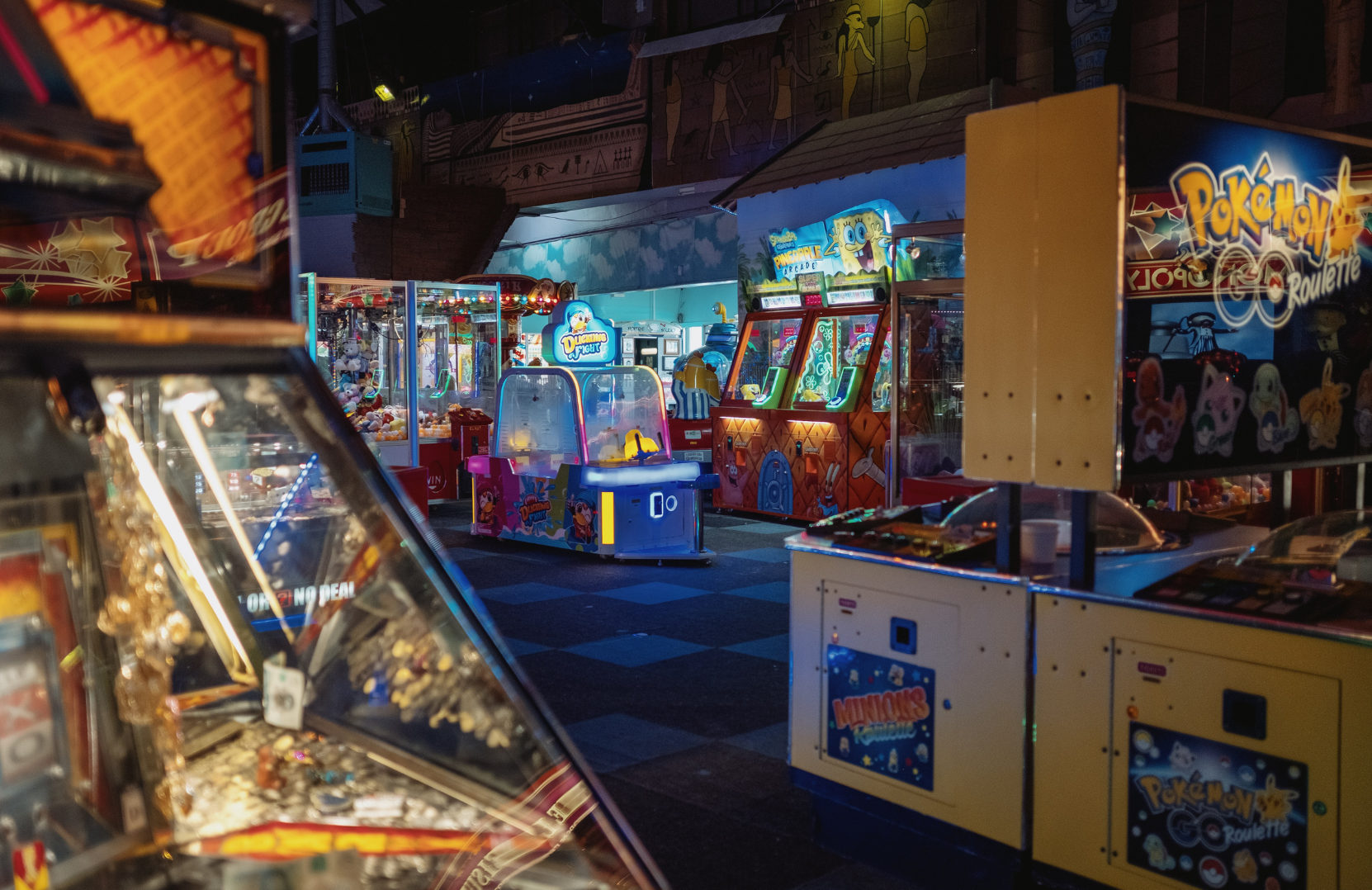If you did not grow up during the age of arcades, it’s relatively hard to explain the culture outside of what we know now as arcade bars like Cineplex’s The Rec Room, Greta, or Beercade. Back in the 1970s and 1980s, arcades were a cultural staple inspiring a generation of gamers. Arcades invaded malls, convenience stores, theme parks, with some even existing as standalone buildings.
From classics like Pac-Man to quarter-eaters like Dragon’s Lair, arcades housed kids and adults alike waiting to play the latest video games with their friends. Arcades represented a place where people could hang out, unwind, and get lost in game worlds created by iconic video game companies like Taito, Sega, and Namco.
Though the emergence of Pong in 1972 brought gaming to the masses, there was still a major disconnect in home video games in comparison to ones found in the arcade. Video game hardware developers like Nolan Bushnell and Ted Dabney’s Atari, Fusajiro Yamauchi’s Nintendo, and Mattel Electronics’ Intellivision found meteoric success in bringing video games into the household. However, at the time, it was challenging to replicate the high-quality games and diverse features of arcade cabinets.
Jeremy Stegehuis, an avid video game fan and collector, says this exclusive high-quality experience of arcades was a massive factor in their popularity.
“Arcades were a lot more powerful than home consoles and phones. You couldn’t have the same experiences at home. You had to go to a place because that’s where the hardware could fit into,” explains Stegehuis.
“That’s where you get the best graphical quality and the best games and all that. And up until the mid-’90s, late ‘90s especially, you wouldn’t be able to get close to that arcade experience at home.”
However, in 2022, the culture around arcades has drastically shifted. As arcades in the ‘70s and ‘80s represented a novel birthplace for video games, now in 2022, arcades have become more of a side attraction.
In Edmonton, this shift in arcade culture can be best represented in the trendy uptick of arcade bars and side arcades tacked onto larger entertainment sites. Instead of arcades taking up their own iconic space as they did in the past, arcades now represent a secondary commodity used as a tool to sell drinks and food or squeeze the last bit of money out of patrons killing time before a movie.
Cole Ostawsky, general manager of Beercade, says this shift in arcade culture has been beneficial, not only in the creation of Beercade but also in opening up different revenue streams.
“On the business side of things, it’s actually a good revenue stream. It gives your patrons and people in the city something to do other than just come in and drink,” says Ostawsky.
Moreover, as arcade culture has shifted, so too have the games. Though older games from Taito, Sega, and Namco are still present in arcade bars, they are often hidden behind machines that are more team-based or representative of giant versions of phone games. For example, it would be hard to find games like Galaga or Joust at The Rec Room, which favours phone games like Press the Lock and Flappy Bird.
However, Ostawsky says having a variety of different games helps Beercade appeal to a broader demographic, which he says ranges from 18 to 40-year-olds.
“The majority of games that are there and (that we) kind of like to push out are the interactive ones like Skee-Ball, basketball — it creates a good competition between two people, three people, four people,” says Ostawsky.
“Then you also have pinball. There’s a bunch of pinball junkies in the city, and having the new-age games (and) old-age games… kind of fits multiple different demographics, which is nice. So, it kind of gives an outlet for everyone.”
Though most arcades in the city are arcade bars, there are some arcades trying to bring back the traditional ways of the past. For instance, Mathew Russell, the owner of Arkadium Retro Arcade located in Sherwood Park, operates a traditional arcade all from his own collection. Russell’s goal with Arkadium is to preserve gaming’s past in the most authentic way possible while acting as an arcade museum for younger generations.
“(Customers) just want to show their kids or relive their youth because it is all retro games…. It’s all original hardware,” explains Russell. “Its original feel, original joysticks, original buttons; they like the originality of what they used to play when they were kids, instead of just playing on their home consoles or phones.”
Unlike Beercade, Russell says Arkadium’s success lies in its nostalgic family oriented approach, akin to arcades of the past.
“We want to keep it family orientated. We don’t want to be the nightclub. We don’t want to be the Greta or the Beercade or those,” says Russell.
However, in running an arcade based in a world that has been phased out, Russell admits he has a harder time maintaining his machines than arcade bars. As arcade bars have the luxury of running new games that have warranty and easy access to maintenance, Arkadium’s machines run on parts that are decades old.
“I’m an electronic engineer, so I can go through and figure out what’s wrong with the game and fix it. Where with these guys (arcade bars), they’re just bars, they just want money pumped in, and they don’t have the skill set to fix them. I think that’s why they go for the newer games,” explains Russell. “Plus, it took me 15 years to acquire what I have. It takes a while to find these games.”
“You just can’t find retro games. There’s not a store that sells them.”
Ostawsky reinforces Russell’s claim, saying that there hasn’t been much issue maintaining Beercade’s machines other than regular wear and tear.
“We have games guys that come in and who service the machines on a daily basis. Obviously, wear and tear and all that kind of comes into play, but for the most part, the games are well taken care of,” says Ostawsky.
Regardless of the long-term impact of arcade bars, one of the significant reasons arcades have waned in popularity is due to the widespread uptake of home consoles and personal computers. Unlike at gaming’s infancy, the video game industry now rakes in billions of dollars in hardware and software sales. For example, according to Eurogamer, Sony’s new Playstation 5 console sold nearly 20 million consoles worldwide since its initial launch in late 2020. In the United States, the console is now the fastest-selling console in U.S. history “in both unit and dollar sales,” as relayed by IGN. Even now, many hangout sessions have moved online to online gaming networks and chats such as Discord.
Stegehuis believes this factor has been a major contributor to the decline of arcades for younger generations.
“A lot of the social aspect to gaming is going to be taken online for most kids. You don’t need to go to a place to meet up and play games together. You can do that at home,” explains Stegehuis. “If you want just these quick, short, addictive experiences, you don’t need to go to an arcade anymore. You can just go on your cell phone and have those quick little one-off games.”
Though arcades have seen relative success using nostalgia or novelty as a selling point, a significant factor remains as a method to success: offering an experience that can’t be found at home. One technological advancement that has led to a change in arcades has been the inclusion of virtual reality (VR). VR allows users to be transported to different worlds through the adoption of a VR headset and set of handheld controllers — allowing for a more interactive and full-body gaming experience.
Eric and Steph Roberge, owners and founders of Game OVR, a VRcade located just out of St. Albert, say VR provides a diverse technology that still isn’t super accessible to the public. Though VR has gone down in price (led by Facebook’s Oculus series and PlayStation VR), it is still quite novel.
“The biggest challenge for us when we got into the VR space five years ago, it was very, very new technology,” says Eric. “It wasn’t very mainstream. So, a lot of it was just getting across to people what it was, how it worked, setting their expectations. So that when they did book and come in, expectations met reality.”
However, VR provides different benefits that traditional arcades cannot match. From on-the-fly access to many interactive games to VR escape rooms, the possibilities of VR are endless.
“VR as a whole is going to only get bigger. There’s so many different applications for it, not just gaming. I would be very surprised to see it not explode and every single industry have something to do with virtual reality,” says Steph.
Though the future look and version of arcades are hazy, it is clear that they continue to stand the test of time due to their timelessness, technology, and social nature.
“There’s the social aspect of it. Video games have always been popular. Since they’ve existed, they’ve always been popular. It’s a fantasy. It’s an escape. I get to be somebody else in a different world,” explains Eric. “Being able to share that with other people is really exciting…. It (is) always a better experience when you’re playing with someone else than when you’re playing by yourself.”
“Those arcades play on that same feeling that you get, going and sharing this adventure together with other people.”





It’s a difficult choice between saving old arcade hardware and saving the spirit of arcade gaming . I prefer to create new hardware for competitive gaming in public spaces that can offer some unusual gaming experience. You are right when you mentioned about evolution of arcade gaming from arcade cabinets to home consoles and then to mobile gaming with hypercasual games. What if it will be possible to “close the loop” and to create simple competitive arcade gaming for public spaces? As a DIY fan I think in this direction. One can find some of my working prototypes in my blog.